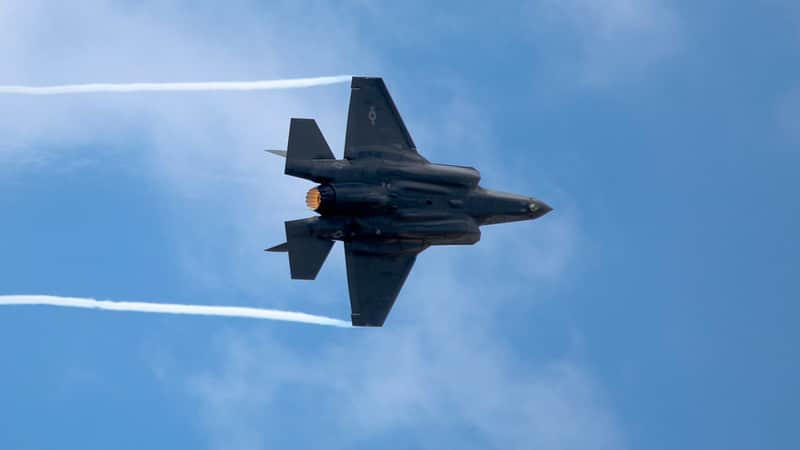Aerospace
US secret 6th-generation ‘fighter’ is now officially in development

USAF NGAD : The power of a country is judged by its defense war machine, and the entire world knows that the United States possesses the most powerful weaponry, which it has been creating for a long time. At the moment, there are just a few 5th generation fighter jets that are stealthy and technologically advanced enough to be high-rated battle machines. However, only a few countries have succeeded in developing such machines. The United States possesses two fighter jets, whereas China and Russia each have a single fighter jet that is said to be a fifth-generation fighter.
On the other side, the United States is working on a 6th generation fighter jet, which was started in 2010 and is expected to be introduced in 2030, and is known as the Next Generations Air Dominance Program.
Lockheed Martin is in charge of the programme, having overseen the development and production of the stealthy F-22 and F-35 fighters. Boeing, on the other hand, might emerge as the NGAD fighter’s dark horse developer.
The F22 is a fighter jet. This aircraft could be replaced by a new 6th generation fighter jet by the end of 2030, with a $9 billion budget for the project.
The NGAD, a new sixth-generation aircraft, can fly as high and as fast as the F22, with a ceiling of 65,000 to 70,000 feet and a top speed of mach2.8. The NGAD’s extraordinary maneuverability, capable of engaging in a tight-turning dogfight, has yet to be discovered. because the aircraft must be tested once the prototype is finished
Meet the world’s fastest business aircraft, the Global 8000.
This highly classified technology can identify enemy stealth aircraft based on their heat signatures. It also has an infrared search and track system. The front of the pods looks to be dielectrically transparent. NGAD may opt to use escort aircraft instead of an AESA on the manned fighter, making the manned platform more difficult to detect.
The GE Aviation XA 100 and the Pratt & Whitney XA 101 engines are two options for this aircraft’s engines. Both made it to the testing stage last fall and will be put to the test over the following two years for durability and other factors. This engine is capable of producing 45 pounds of thrust.
How did DARPA’s Black Hawk fly without a pilot?
This fighter jet has the AIM 260 A tactical missile, Modular Advanced missiles that can be shoot from Air to air and Air to ground missile. It has Peregrine and Cuda and Hypersonic weapons system, Aircraft may also have capacity produce the 150 kw power which can operate the self-protect high-energy laser demonstrator system.
Let us know what you think of America’s newest 6th generation fighter in the comments box, and tell us what your favourite fighter jet aircraft is.
These airlines are offering the most expensive San Francisco to Frankfurt tickets.

Aerospace
Boeing Transfers Rocket Stage to NASA, Paving Way for Human Moon Mission

Boeing has achieved a significant milestone by providing NASA with the second core stage of the Space Launch System (SLS) rocket.
This crucial component, crafted at NASA’s Michoud Assembly Facility (MAF), is set to propel the Artemis II crew into lunar orbit, marking humanity’s return to deep space after a 50-year hiatus.
The monumental Boeing-built rocket stage, the largest element of the Artemis II mission, will embark on a journey aboard the Pegasus barge, traveling 900 miles to NASA’s Kennedy Space Center.
Comparison of two legendary aircraft B777x vs B747 aircraft:Click here
Upon arrival, it will be meticulously integrated with other essential Artemis II components, including the upper stage, solid rocket boosters, and NASA’s Orion spacecraft within the iconic Vehicle Assembly Building. This intricate integration process is a vital step toward the eagerly anticipated Artemis II launch, slated for 2025.
“Boeing-built products helped land humankind on the moon in 1969, and we’re proud to continue that legacy through the Artemis generation,” remarked Dave Dutcher, vice president and program manager for Boeing’s SLS program. “Together, with NASA and our industry partners and suppliers, we are building the world’s most capable rocket and paving the way to deep space through America’s rocket factory in New Orleans.”
NASA, Lockheed Martin Reveal X-59 Quiet Supersonic Aircraft:Click here
The delivery of Core Stage 2 marks a significant achievement in the evolution of the SLS rocket. Towering over 200 feet and powered by four RS-25 engines, this core stage, coupled with two solid-fueled booster rockets, will generate a staggering 8.8 million pounds of thrust. This immense power is crucial to launching Artemis II and future missions into the vast expanse of space.
The SLS rocket stands unparalleled in its capability to transport both crew and substantial cargo to the moon and beyond in a single launch. Its extraordinary capacity will facilitate the delivery of human-rated spacecraft, habitats, and scientific missions to destinations including the moon and Mars, ushering in a new era of space exploration.
-

 Travel1 week ago
Travel1 week agoAir India to Expand US Operations with Three New Routes After a Decade
-

 Travel2 weeks ago
Travel2 weeks agoWhy We Should Avoid These Stamps in a Passport
-

 Airlines1 month ago
Airlines1 month agoInvestigations Reveal Fake Chinese Titanium in Boeing and Airbus Jets
-

 Tech4 weeks ago
Tech4 weeks agoChina’s CATL Plans 1,800-Mile Electric Plane Launch by 2027
-

 Airport3 days ago
Airport3 days agoTop 10 Largest Airports in the World by Size
-

 Aerospace4 weeks ago
Aerospace4 weeks agoChina’s Fighter Jets Turn Wings into Autonomous Drones
-

 Airlines4 days ago
Airlines4 days agoAir India Rolls Out A350s for Delhi-New York JFK and Newark Routes
-

 Defence3 weeks ago
Defence3 weeks agoBoeing Enhances Chinook with New Engines and Block II Upgrades at $96 Million







